Business and Company Law: Partnership and Liability Analysis Report
VerifiedAdded on 2020/03/16
|10
|2666
|48
Report
AI Summary
This report provides a legal analysis of a business and company law case involving a florist shop, examining the potential liabilities of individuals involved in the business, specifically Violet and Sonny. The report investigates whether a partnership existed between the parties, considering the roles and responsibilities of each individual, the sharing of profits and losses, and the application of the Partnership Act 1892. The analysis considers the legal definitions of a partnership, the rights and liabilities of partners, and the implications of loan agreements. The report concludes that Violet is considered a partner and therefore liable for the debt, while Sonny is not, based on their respective roles and the provisions of the law. It cites relevant case law and statutory rules to support its conclusions.
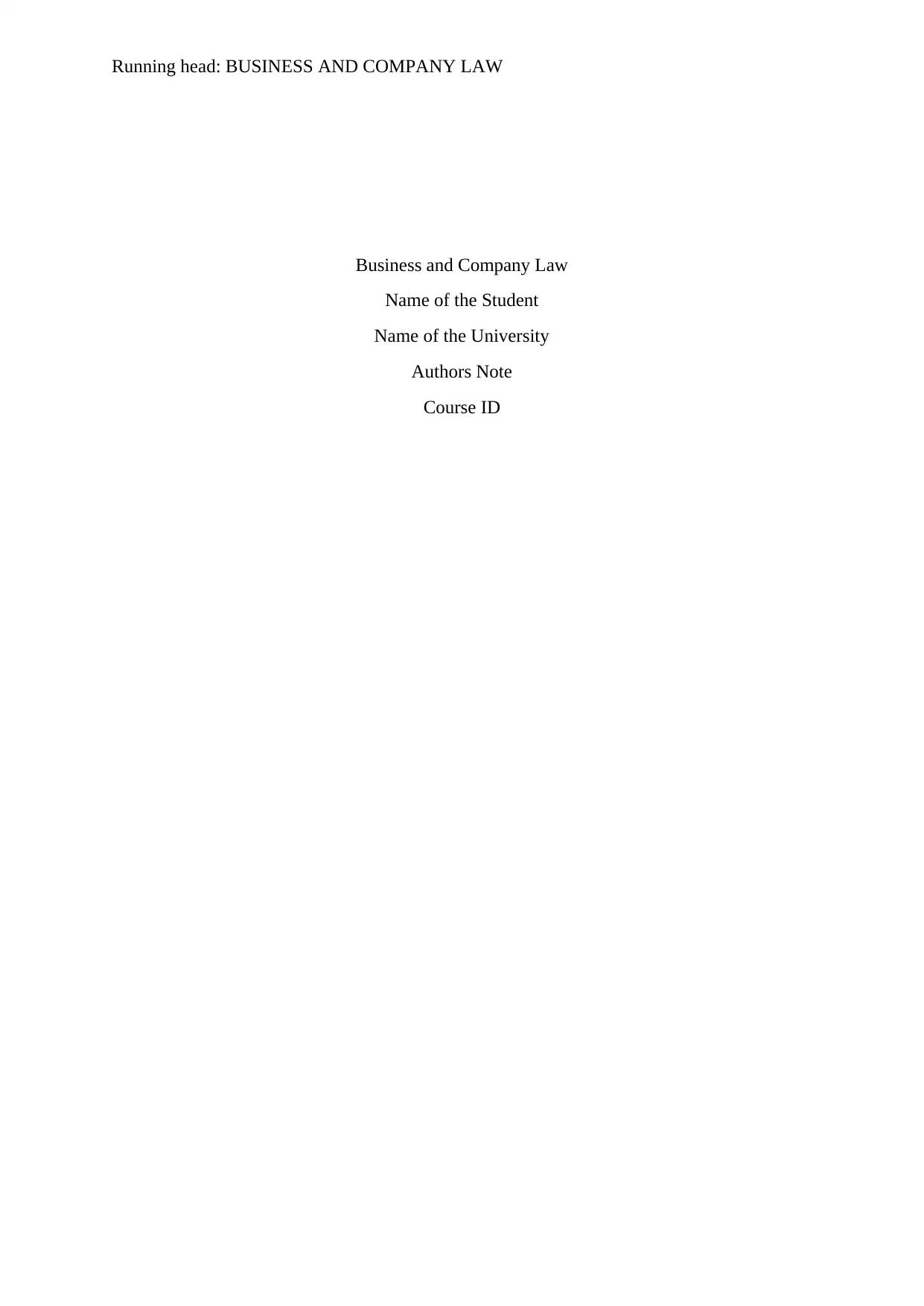
Running head: BUSINESS AND COMPANY LAW
Business and Company Law
Name of the Student
Name of the University
Authors Note
Course ID
Business and Company Law
Name of the Student
Name of the University
Authors Note
Course ID
Paraphrase This Document
Need a fresh take? Get an instant paraphrase of this document with our AI Paraphraser
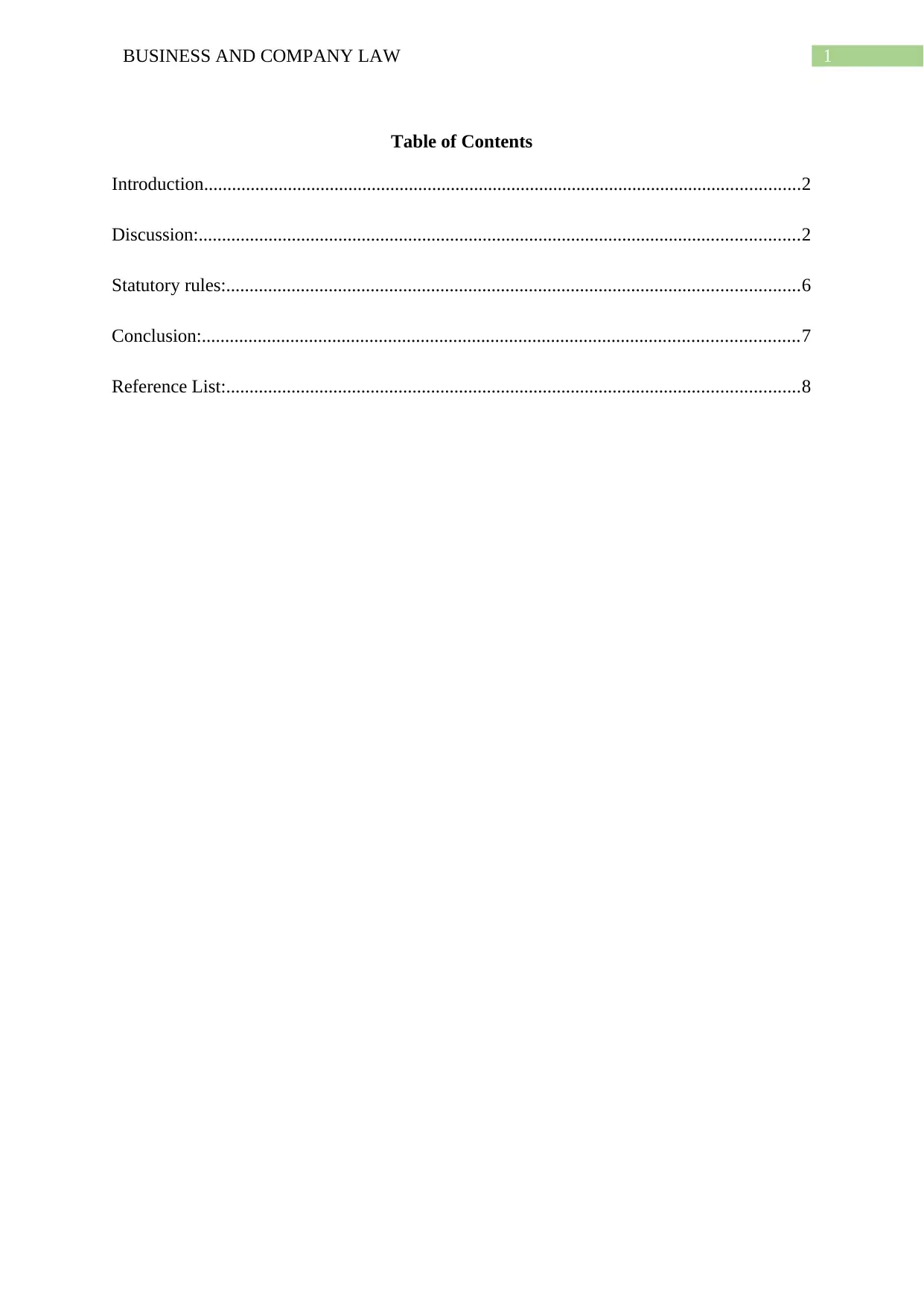
1BUSINESS AND COMPANY LAW
Table of Contents
Introduction................................................................................................................................2
Discussion:.................................................................................................................................2
Statutory rules:...........................................................................................................................6
Conclusion:................................................................................................................................7
Reference List:...........................................................................................................................8
Table of Contents
Introduction................................................................................................................................2
Discussion:.................................................................................................................................2
Statutory rules:...........................................................................................................................6
Conclusion:................................................................................................................................7
Reference List:...........................................................................................................................8
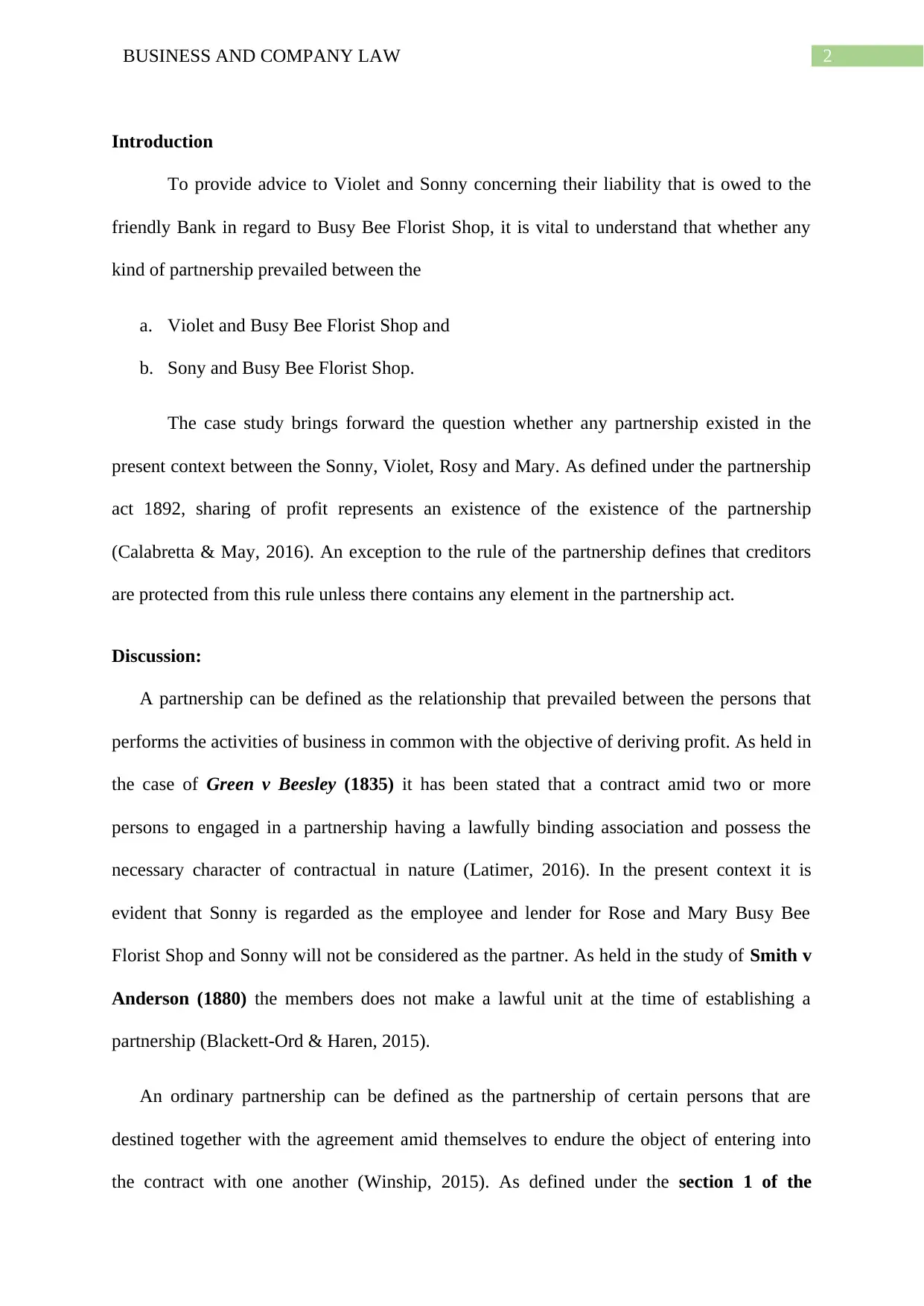
2BUSINESS AND COMPANY LAW
Introduction
To provide advice to Violet and Sonny concerning their liability that is owed to the
friendly Bank in regard to Busy Bee Florist Shop, it is vital to understand that whether any
kind of partnership prevailed between the
a. Violet and Busy Bee Florist Shop and
b. Sony and Busy Bee Florist Shop.
The case study brings forward the question whether any partnership existed in the
present context between the Sonny, Violet, Rosy and Mary. As defined under the partnership
act 1892, sharing of profit represents an existence of the existence of the partnership
(Calabretta & May, 2016). An exception to the rule of the partnership defines that creditors
are protected from this rule unless there contains any element in the partnership act.
Discussion:
A partnership can be defined as the relationship that prevailed between the persons that
performs the activities of business in common with the objective of deriving profit. As held in
the case of Green v Beesley (1835) it has been stated that a contract amid two or more
persons to engaged in a partnership having a lawfully binding association and possess the
necessary character of contractual in nature (Latimer, 2016). In the present context it is
evident that Sonny is regarded as the employee and lender for Rose and Mary Busy Bee
Florist Shop and Sonny will not be considered as the partner. As held in the study of Smith v
Anderson (1880) the members does not make a lawful unit at the time of establishing a
partnership (Blackett-Ord & Haren, 2015).
An ordinary partnership can be defined as the partnership of certain persons that are
destined together with the agreement amid themselves to endure the object of entering into
the contract with one another (Winship, 2015). As defined under the section 1 of the
Introduction
To provide advice to Violet and Sonny concerning their liability that is owed to the
friendly Bank in regard to Busy Bee Florist Shop, it is vital to understand that whether any
kind of partnership prevailed between the
a. Violet and Busy Bee Florist Shop and
b. Sony and Busy Bee Florist Shop.
The case study brings forward the question whether any partnership existed in the
present context between the Sonny, Violet, Rosy and Mary. As defined under the partnership
act 1892, sharing of profit represents an existence of the existence of the partnership
(Calabretta & May, 2016). An exception to the rule of the partnership defines that creditors
are protected from this rule unless there contains any element in the partnership act.
Discussion:
A partnership can be defined as the relationship that prevailed between the persons that
performs the activities of business in common with the objective of deriving profit. As held in
the case of Green v Beesley (1835) it has been stated that a contract amid two or more
persons to engaged in a partnership having a lawfully binding association and possess the
necessary character of contractual in nature (Latimer, 2016). In the present context it is
evident that Sonny is regarded as the employee and lender for Rose and Mary Busy Bee
Florist Shop and Sonny will not be considered as the partner. As held in the study of Smith v
Anderson (1880) the members does not make a lawful unit at the time of establishing a
partnership (Blackett-Ord & Haren, 2015).
An ordinary partnership can be defined as the partnership of certain persons that are
destined together with the agreement amid themselves to endure the object of entering into
the contract with one another (Winship, 2015). As defined under the section 1 of the
⊘ This is a preview!⊘
Do you want full access?
Subscribe today to unlock all pages.

Trusted by 1+ million students worldwide
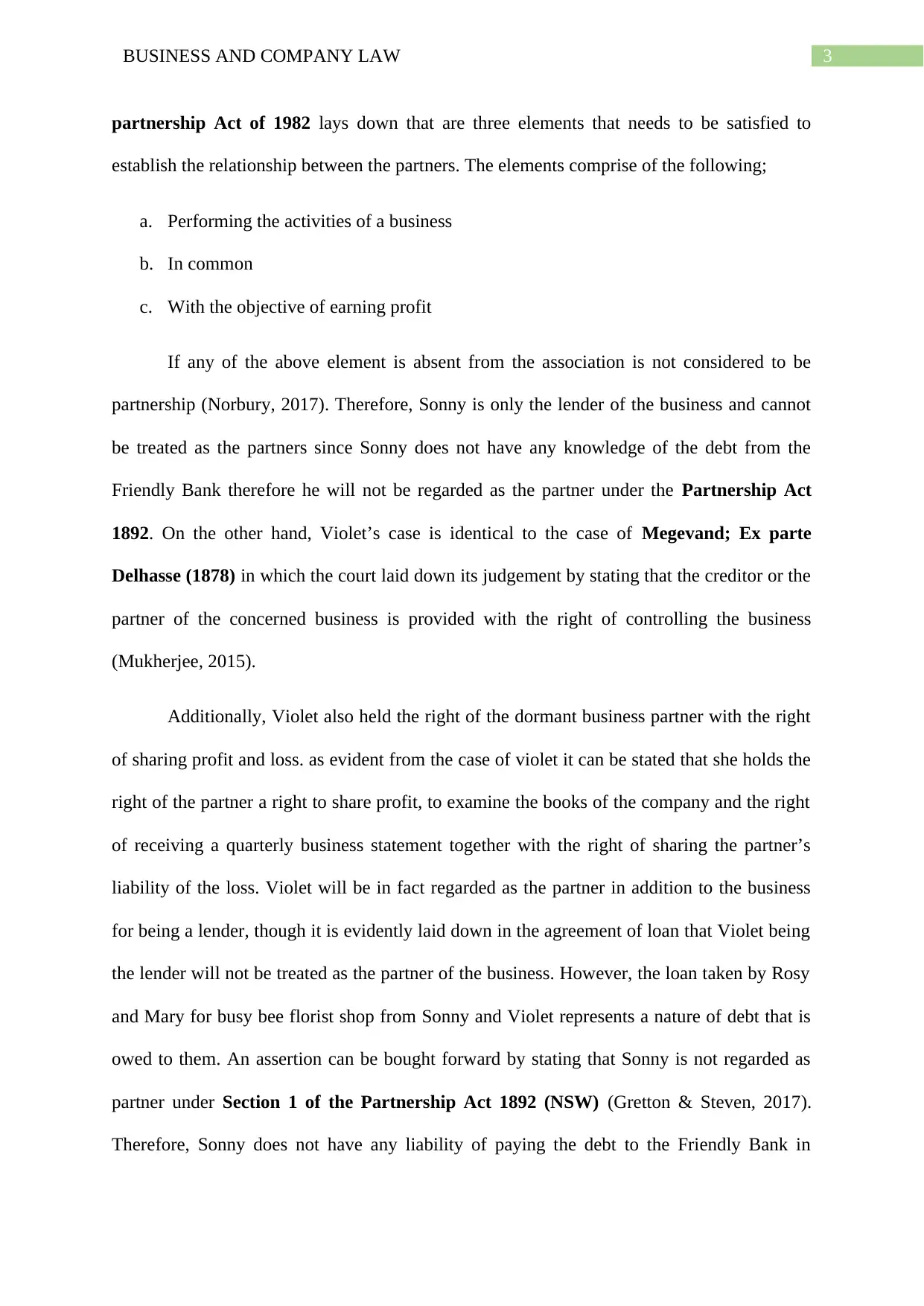
3BUSINESS AND COMPANY LAW
partnership Act of 1982 lays down that are three elements that needs to be satisfied to
establish the relationship between the partners. The elements comprise of the following;
a. Performing the activities of a business
b. In common
c. With the objective of earning profit
If any of the above element is absent from the association is not considered to be
partnership (Norbury, 2017). Therefore, Sonny is only the lender of the business and cannot
be treated as the partners since Sonny does not have any knowledge of the debt from the
Friendly Bank therefore he will not be regarded as the partner under the Partnership Act
1892. On the other hand, Violet’s case is identical to the case of Megevand; Ex parte
Delhasse (1878) in which the court laid down its judgement by stating that the creditor or the
partner of the concerned business is provided with the right of controlling the business
(Mukherjee, 2015).
Additionally, Violet also held the right of the dormant business partner with the right
of sharing profit and loss. as evident from the case of violet it can be stated that she holds the
right of the partner a right to share profit, to examine the books of the company and the right
of receiving a quarterly business statement together with the right of sharing the partner’s
liability of the loss. Violet will be in fact regarded as the partner in addition to the business
for being a lender, though it is evidently laid down in the agreement of loan that Violet being
the lender will not be treated as the partner of the business. However, the loan taken by Rosy
and Mary for busy bee florist shop from Sonny and Violet represents a nature of debt that is
owed to them. An assertion can be bought forward by stating that Sonny is not regarded as
partner under Section 1 of the Partnership Act 1892 (NSW) (Gretton & Steven, 2017).
Therefore, Sonny does not have any liability of paying the debt to the Friendly Bank in
partnership Act of 1982 lays down that are three elements that needs to be satisfied to
establish the relationship between the partners. The elements comprise of the following;
a. Performing the activities of a business
b. In common
c. With the objective of earning profit
If any of the above element is absent from the association is not considered to be
partnership (Norbury, 2017). Therefore, Sonny is only the lender of the business and cannot
be treated as the partners since Sonny does not have any knowledge of the debt from the
Friendly Bank therefore he will not be regarded as the partner under the Partnership Act
1892. On the other hand, Violet’s case is identical to the case of Megevand; Ex parte
Delhasse (1878) in which the court laid down its judgement by stating that the creditor or the
partner of the concerned business is provided with the right of controlling the business
(Mukherjee, 2015).
Additionally, Violet also held the right of the dormant business partner with the right
of sharing profit and loss. as evident from the case of violet it can be stated that she holds the
right of the partner a right to share profit, to examine the books of the company and the right
of receiving a quarterly business statement together with the right of sharing the partner’s
liability of the loss. Violet will be in fact regarded as the partner in addition to the business
for being a lender, though it is evidently laid down in the agreement of loan that Violet being
the lender will not be treated as the partner of the business. However, the loan taken by Rosy
and Mary for busy bee florist shop from Sonny and Violet represents a nature of debt that is
owed to them. An assertion can be bought forward by stating that Sonny is not regarded as
partner under Section 1 of the Partnership Act 1892 (NSW) (Gretton & Steven, 2017).
Therefore, Sonny does not have any liability of paying the debt to the Friendly Bank in
Paraphrase This Document
Need a fresh take? Get an instant paraphrase of this document with our AI Paraphraser
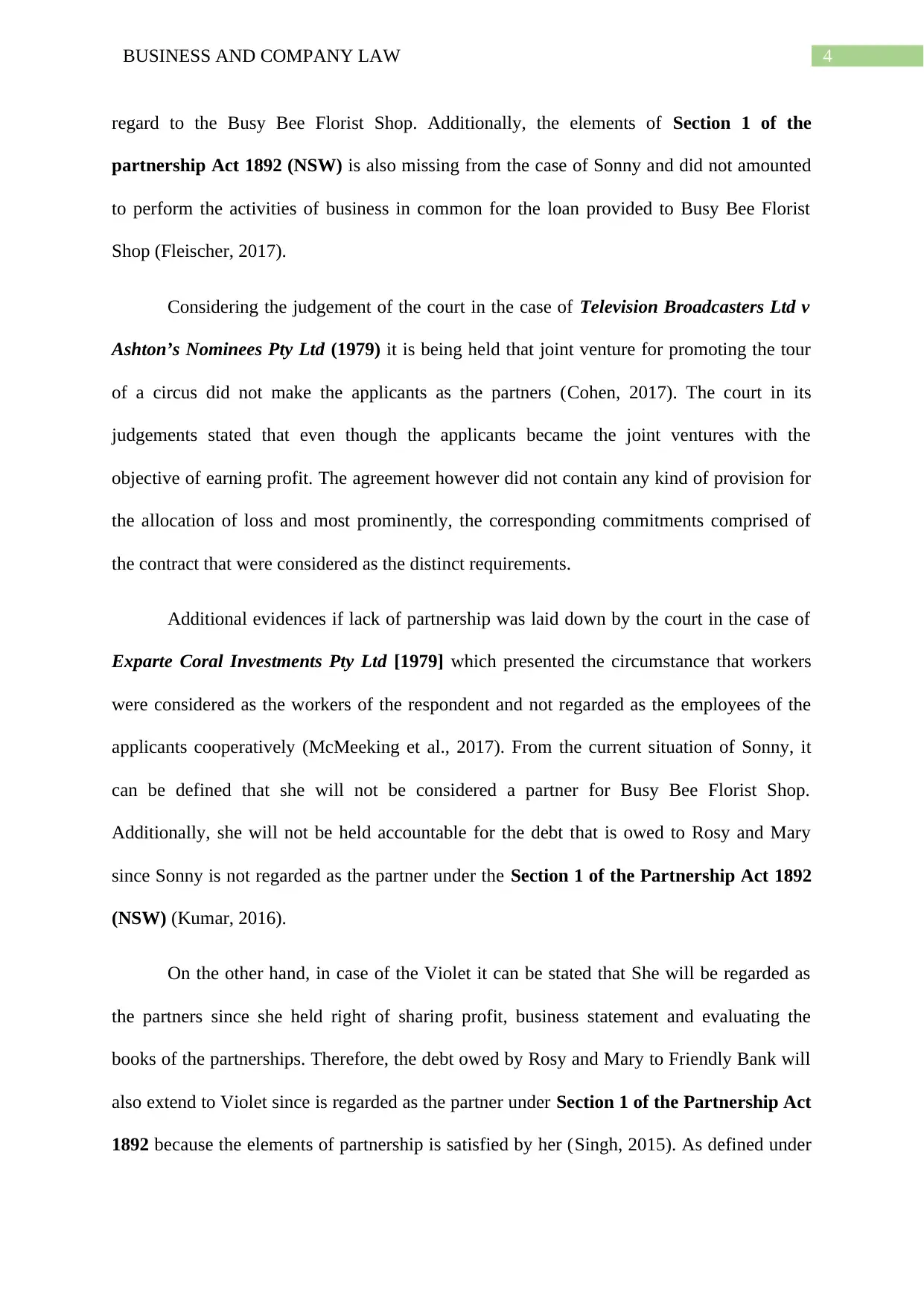
4BUSINESS AND COMPANY LAW
regard to the Busy Bee Florist Shop. Additionally, the elements of Section 1 of the
partnership Act 1892 (NSW) is also missing from the case of Sonny and did not amounted
to perform the activities of business in common for the loan provided to Busy Bee Florist
Shop (Fleischer, 2017).
Considering the judgement of the court in the case of Television Broadcasters Ltd v
Ashton’s Nominees Pty Ltd (1979) it is being held that joint venture for promoting the tour
of a circus did not make the applicants as the partners (Cohen, 2017). The court in its
judgements stated that even though the applicants became the joint ventures with the
objective of earning profit. The agreement however did not contain any kind of provision for
the allocation of loss and most prominently, the corresponding commitments comprised of
the contract that were considered as the distinct requirements.
Additional evidences if lack of partnership was laid down by the court in the case of
Exparte Coral Investments Pty Ltd [1979] which presented the circumstance that workers
were considered as the workers of the respondent and not regarded as the employees of the
applicants cooperatively (McMeeking et al., 2017). From the current situation of Sonny, it
can be defined that she will not be considered a partner for Busy Bee Florist Shop.
Additionally, she will not be held accountable for the debt that is owed to Rosy and Mary
since Sonny is not regarded as the partner under the Section 1 of the Partnership Act 1892
(NSW) (Kumar, 2016).
On the other hand, in case of the Violet it can be stated that She will be regarded as
the partners since she held right of sharing profit, business statement and evaluating the
books of the partnerships. Therefore, the debt owed by Rosy and Mary to Friendly Bank will
also extend to Violet since is regarded as the partner under Section 1 of the Partnership Act
1892 because the elements of partnership is satisfied by her (Singh, 2015). As defined under
regard to the Busy Bee Florist Shop. Additionally, the elements of Section 1 of the
partnership Act 1892 (NSW) is also missing from the case of Sonny and did not amounted
to perform the activities of business in common for the loan provided to Busy Bee Florist
Shop (Fleischer, 2017).
Considering the judgement of the court in the case of Television Broadcasters Ltd v
Ashton’s Nominees Pty Ltd (1979) it is being held that joint venture for promoting the tour
of a circus did not make the applicants as the partners (Cohen, 2017). The court in its
judgements stated that even though the applicants became the joint ventures with the
objective of earning profit. The agreement however did not contain any kind of provision for
the allocation of loss and most prominently, the corresponding commitments comprised of
the contract that were considered as the distinct requirements.
Additional evidences if lack of partnership was laid down by the court in the case of
Exparte Coral Investments Pty Ltd [1979] which presented the circumstance that workers
were considered as the workers of the respondent and not regarded as the employees of the
applicants cooperatively (McMeeking et al., 2017). From the current situation of Sonny, it
can be defined that she will not be considered a partner for Busy Bee Florist Shop.
Additionally, she will not be held accountable for the debt that is owed to Rosy and Mary
since Sonny is not regarded as the partner under the Section 1 of the Partnership Act 1892
(NSW) (Kumar, 2016).
On the other hand, in case of the Violet it can be stated that She will be regarded as
the partners since she held right of sharing profit, business statement and evaluating the
books of the partnerships. Therefore, the debt owed by Rosy and Mary to Friendly Bank will
also extend to Violet since is regarded as the partner under Section 1 of the Partnership Act
1892 because the elements of partnership is satisfied by her (Singh, 2015). As defined under
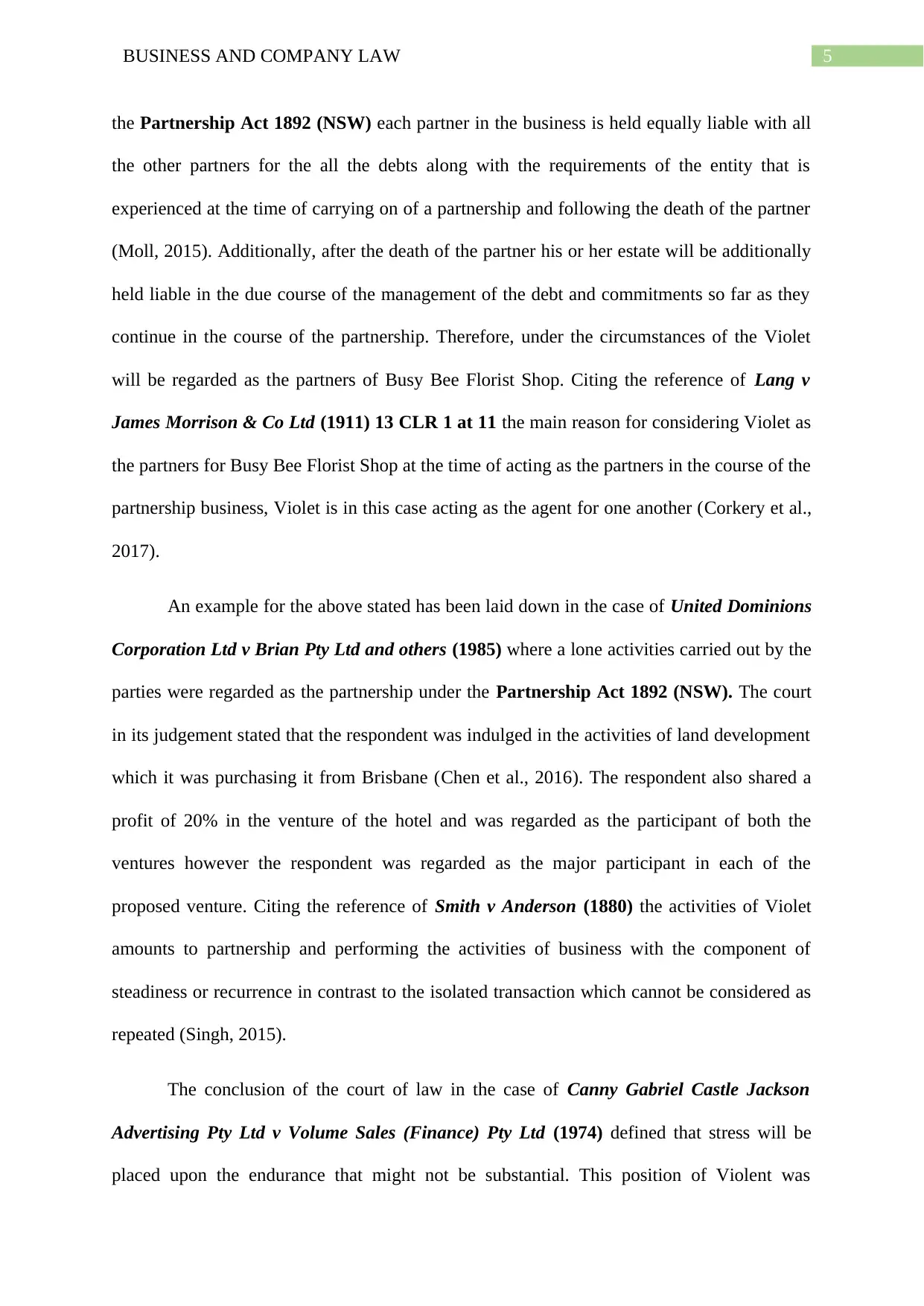
5BUSINESS AND COMPANY LAW
the Partnership Act 1892 (NSW) each partner in the business is held equally liable with all
the other partners for the all the debts along with the requirements of the entity that is
experienced at the time of carrying on of a partnership and following the death of the partner
(Moll, 2015). Additionally, after the death of the partner his or her estate will be additionally
held liable in the due course of the management of the debt and commitments so far as they
continue in the course of the partnership. Therefore, under the circumstances of the Violet
will be regarded as the partners of Busy Bee Florist Shop. Citing the reference of Lang v
James Morrison & Co Ltd (1911) 13 CLR 1 at 11 the main reason for considering Violet as
the partners for Busy Bee Florist Shop at the time of acting as the partners in the course of the
partnership business, Violet is in this case acting as the agent for one another (Corkery et al.,
2017).
An example for the above stated has been laid down in the case of United Dominions
Corporation Ltd v Brian Pty Ltd and others (1985) where a lone activities carried out by the
parties were regarded as the partnership under the Partnership Act 1892 (NSW). The court
in its judgement stated that the respondent was indulged in the activities of land development
which it was purchasing it from Brisbane (Chen et al., 2016). The respondent also shared a
profit of 20% in the venture of the hotel and was regarded as the participant of both the
ventures however the respondent was regarded as the major participant in each of the
proposed venture. Citing the reference of Smith v Anderson (1880) the activities of Violet
amounts to partnership and performing the activities of business with the component of
steadiness or recurrence in contrast to the isolated transaction which cannot be considered as
repeated (Singh, 2015).
The conclusion of the court of law in the case of Canny Gabriel Castle Jackson
Advertising Pty Ltd v Volume Sales (Finance) Pty Ltd (1974) defined that stress will be
placed upon the endurance that might not be substantial. This position of Violent was
the Partnership Act 1892 (NSW) each partner in the business is held equally liable with all
the other partners for the all the debts along with the requirements of the entity that is
experienced at the time of carrying on of a partnership and following the death of the partner
(Moll, 2015). Additionally, after the death of the partner his or her estate will be additionally
held liable in the due course of the management of the debt and commitments so far as they
continue in the course of the partnership. Therefore, under the circumstances of the Violet
will be regarded as the partners of Busy Bee Florist Shop. Citing the reference of Lang v
James Morrison & Co Ltd (1911) 13 CLR 1 at 11 the main reason for considering Violet as
the partners for Busy Bee Florist Shop at the time of acting as the partners in the course of the
partnership business, Violet is in this case acting as the agent for one another (Corkery et al.,
2017).
An example for the above stated has been laid down in the case of United Dominions
Corporation Ltd v Brian Pty Ltd and others (1985) where a lone activities carried out by the
parties were regarded as the partnership under the Partnership Act 1892 (NSW). The court
in its judgement stated that the respondent was indulged in the activities of land development
which it was purchasing it from Brisbane (Chen et al., 2016). The respondent also shared a
profit of 20% in the venture of the hotel and was regarded as the participant of both the
ventures however the respondent was regarded as the major participant in each of the
proposed venture. Citing the reference of Smith v Anderson (1880) the activities of Violet
amounts to partnership and performing the activities of business with the component of
steadiness or recurrence in contrast to the isolated transaction which cannot be considered as
repeated (Singh, 2015).
The conclusion of the court of law in the case of Canny Gabriel Castle Jackson
Advertising Pty Ltd v Volume Sales (Finance) Pty Ltd (1974) defined that stress will be
placed upon the endurance that might not be substantial. This position of Violent was
⊘ This is a preview!⊘
Do you want full access?
Subscribe today to unlock all pages.

Trusted by 1+ million students worldwide
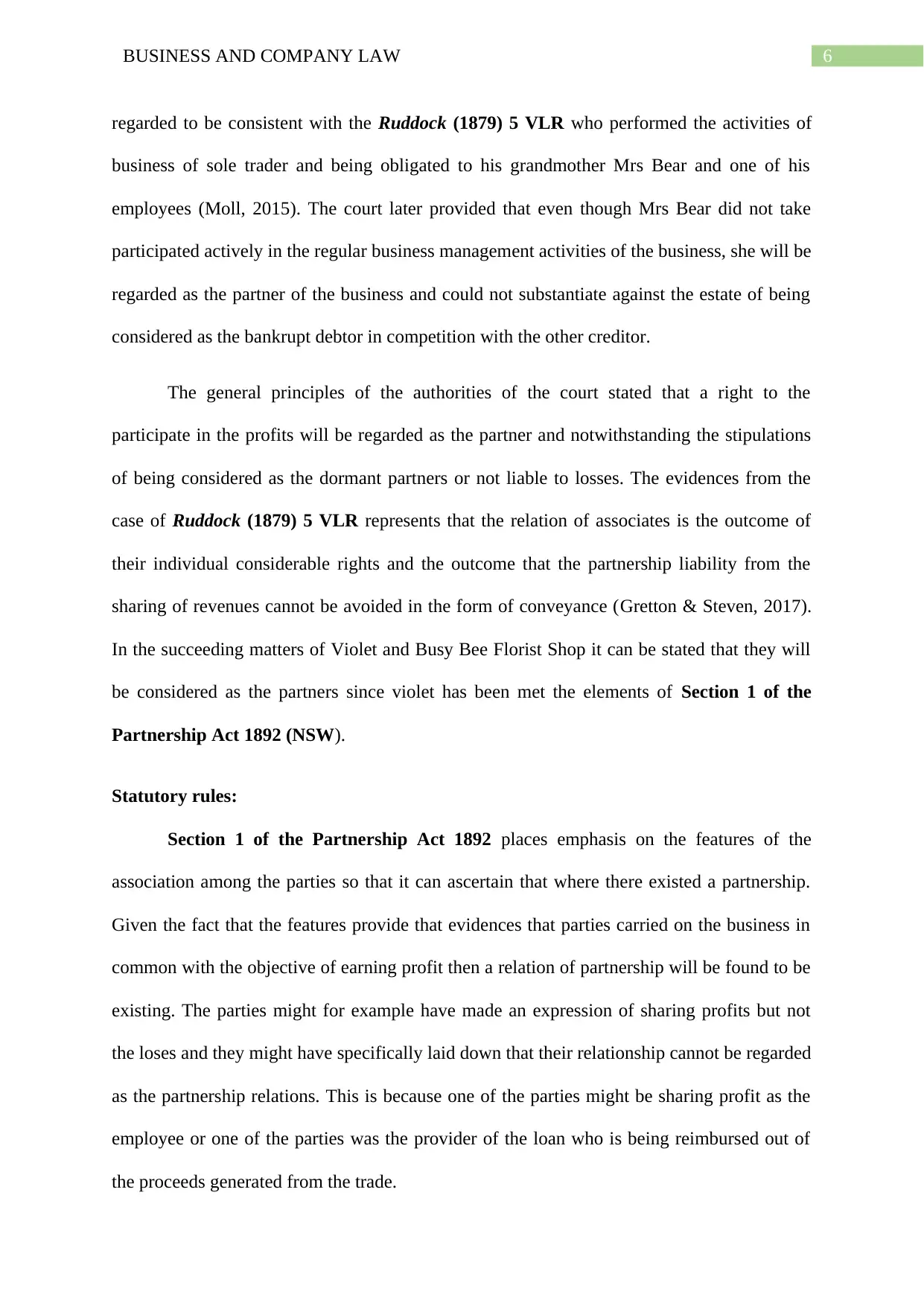
6BUSINESS AND COMPANY LAW
regarded to be consistent with the Ruddock (1879) 5 VLR who performed the activities of
business of sole trader and being obligated to his grandmother Mrs Bear and one of his
employees (Moll, 2015). The court later provided that even though Mrs Bear did not take
participated actively in the regular business management activities of the business, she will be
regarded as the partner of the business and could not substantiate against the estate of being
considered as the bankrupt debtor in competition with the other creditor.
The general principles of the authorities of the court stated that a right to the
participate in the profits will be regarded as the partner and notwithstanding the stipulations
of being considered as the dormant partners or not liable to losses. The evidences from the
case of Ruddock (1879) 5 VLR represents that the relation of associates is the outcome of
their individual considerable rights and the outcome that the partnership liability from the
sharing of revenues cannot be avoided in the form of conveyance (Gretton & Steven, 2017).
In the succeeding matters of Violet and Busy Bee Florist Shop it can be stated that they will
be considered as the partners since violet has been met the elements of Section 1 of the
Partnership Act 1892 (NSW).
Statutory rules:
Section 1 of the Partnership Act 1892 places emphasis on the features of the
association among the parties so that it can ascertain that where there existed a partnership.
Given the fact that the features provide that evidences that parties carried on the business in
common with the objective of earning profit then a relation of partnership will be found to be
existing. The parties might for example have made an expression of sharing profits but not
the loses and they might have specifically laid down that their relationship cannot be regarded
as the partnership relations. This is because one of the parties might be sharing profit as the
employee or one of the parties was the provider of the loan who is being reimbursed out of
the proceeds generated from the trade.
regarded to be consistent with the Ruddock (1879) 5 VLR who performed the activities of
business of sole trader and being obligated to his grandmother Mrs Bear and one of his
employees (Moll, 2015). The court later provided that even though Mrs Bear did not take
participated actively in the regular business management activities of the business, she will be
regarded as the partner of the business and could not substantiate against the estate of being
considered as the bankrupt debtor in competition with the other creditor.
The general principles of the authorities of the court stated that a right to the
participate in the profits will be regarded as the partner and notwithstanding the stipulations
of being considered as the dormant partners or not liable to losses. The evidences from the
case of Ruddock (1879) 5 VLR represents that the relation of associates is the outcome of
their individual considerable rights and the outcome that the partnership liability from the
sharing of revenues cannot be avoided in the form of conveyance (Gretton & Steven, 2017).
In the succeeding matters of Violet and Busy Bee Florist Shop it can be stated that they will
be considered as the partners since violet has been met the elements of Section 1 of the
Partnership Act 1892 (NSW).
Statutory rules:
Section 1 of the Partnership Act 1892 places emphasis on the features of the
association among the parties so that it can ascertain that where there existed a partnership.
Given the fact that the features provide that evidences that parties carried on the business in
common with the objective of earning profit then a relation of partnership will be found to be
existing. The parties might for example have made an expression of sharing profits but not
the loses and they might have specifically laid down that their relationship cannot be regarded
as the partnership relations. This is because one of the parties might be sharing profit as the
employee or one of the parties was the provider of the loan who is being reimbursed out of
the proceeds generated from the trade.
Paraphrase This Document
Need a fresh take? Get an instant paraphrase of this document with our AI Paraphraser
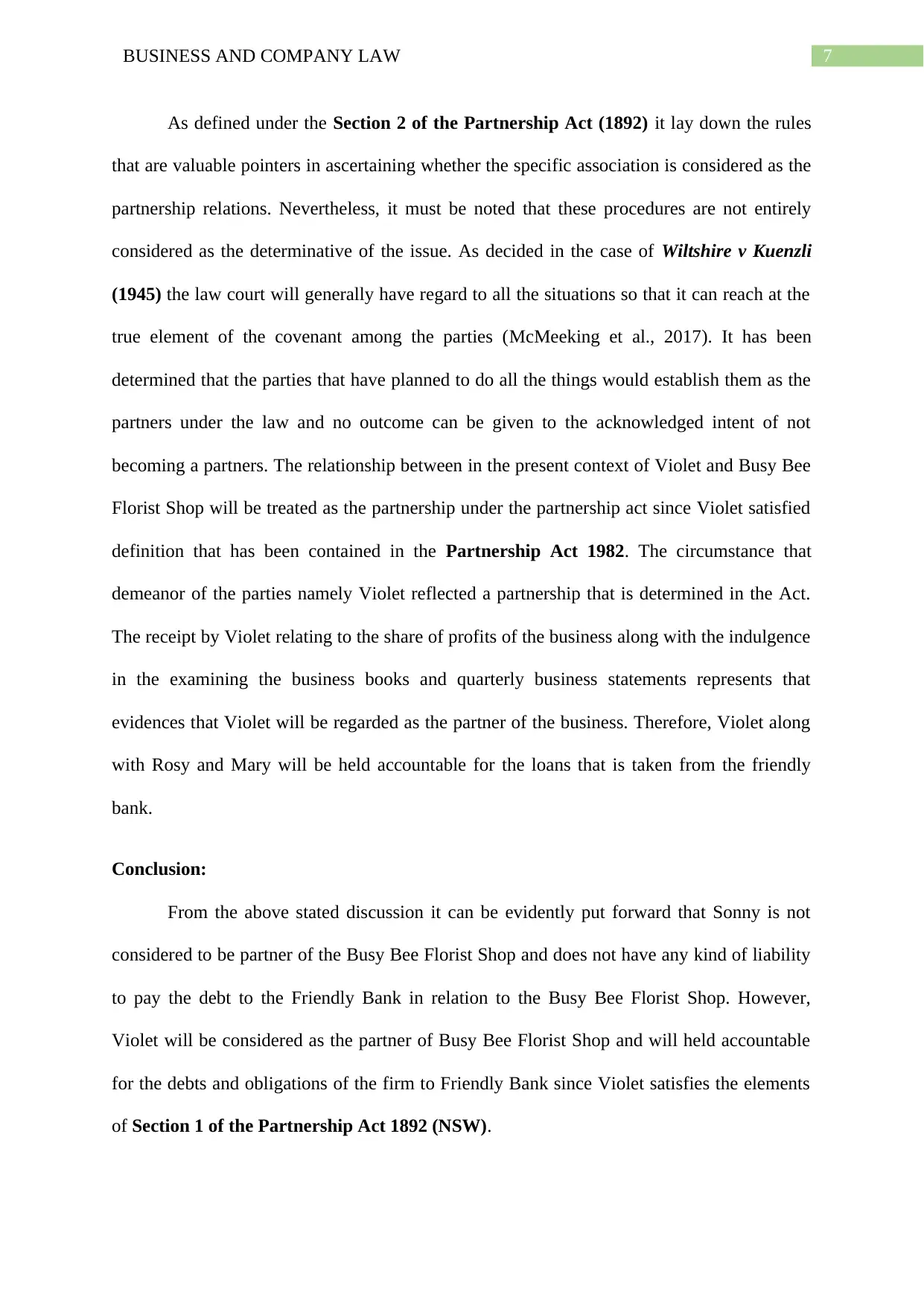
7BUSINESS AND COMPANY LAW
As defined under the Section 2 of the Partnership Act (1892) it lay down the rules
that are valuable pointers in ascertaining whether the specific association is considered as the
partnership relations. Nevertheless, it must be noted that these procedures are not entirely
considered as the determinative of the issue. As decided in the case of Wiltshire v Kuenzli
(1945) the law court will generally have regard to all the situations so that it can reach at the
true element of the covenant among the parties (McMeeking et al., 2017). It has been
determined that the parties that have planned to do all the things would establish them as the
partners under the law and no outcome can be given to the acknowledged intent of not
becoming a partners. The relationship between in the present context of Violet and Busy Bee
Florist Shop will be treated as the partnership under the partnership act since Violet satisfied
definition that has been contained in the Partnership Act 1982. The circumstance that
demeanor of the parties namely Violet reflected a partnership that is determined in the Act.
The receipt by Violet relating to the share of profits of the business along with the indulgence
in the examining the business books and quarterly business statements represents that
evidences that Violet will be regarded as the partner of the business. Therefore, Violet along
with Rosy and Mary will be held accountable for the loans that is taken from the friendly
bank.
Conclusion:
From the above stated discussion it can be evidently put forward that Sonny is not
considered to be partner of the Busy Bee Florist Shop and does not have any kind of liability
to pay the debt to the Friendly Bank in relation to the Busy Bee Florist Shop. However,
Violet will be considered as the partner of Busy Bee Florist Shop and will held accountable
for the debts and obligations of the firm to Friendly Bank since Violet satisfies the elements
of Section 1 of the Partnership Act 1892 (NSW).
As defined under the Section 2 of the Partnership Act (1892) it lay down the rules
that are valuable pointers in ascertaining whether the specific association is considered as the
partnership relations. Nevertheless, it must be noted that these procedures are not entirely
considered as the determinative of the issue. As decided in the case of Wiltshire v Kuenzli
(1945) the law court will generally have regard to all the situations so that it can reach at the
true element of the covenant among the parties (McMeeking et al., 2017). It has been
determined that the parties that have planned to do all the things would establish them as the
partners under the law and no outcome can be given to the acknowledged intent of not
becoming a partners. The relationship between in the present context of Violet and Busy Bee
Florist Shop will be treated as the partnership under the partnership act since Violet satisfied
definition that has been contained in the Partnership Act 1982. The circumstance that
demeanor of the parties namely Violet reflected a partnership that is determined in the Act.
The receipt by Violet relating to the share of profits of the business along with the indulgence
in the examining the business books and quarterly business statements represents that
evidences that Violet will be regarded as the partner of the business. Therefore, Violet along
with Rosy and Mary will be held accountable for the loans that is taken from the friendly
bank.
Conclusion:
From the above stated discussion it can be evidently put forward that Sonny is not
considered to be partner of the Busy Bee Florist Shop and does not have any kind of liability
to pay the debt to the Friendly Bank in relation to the Busy Bee Florist Shop. However,
Violet will be considered as the partner of Busy Bee Florist Shop and will held accountable
for the debts and obligations of the firm to Friendly Bank since Violet satisfies the elements
of Section 1 of the Partnership Act 1892 (NSW).
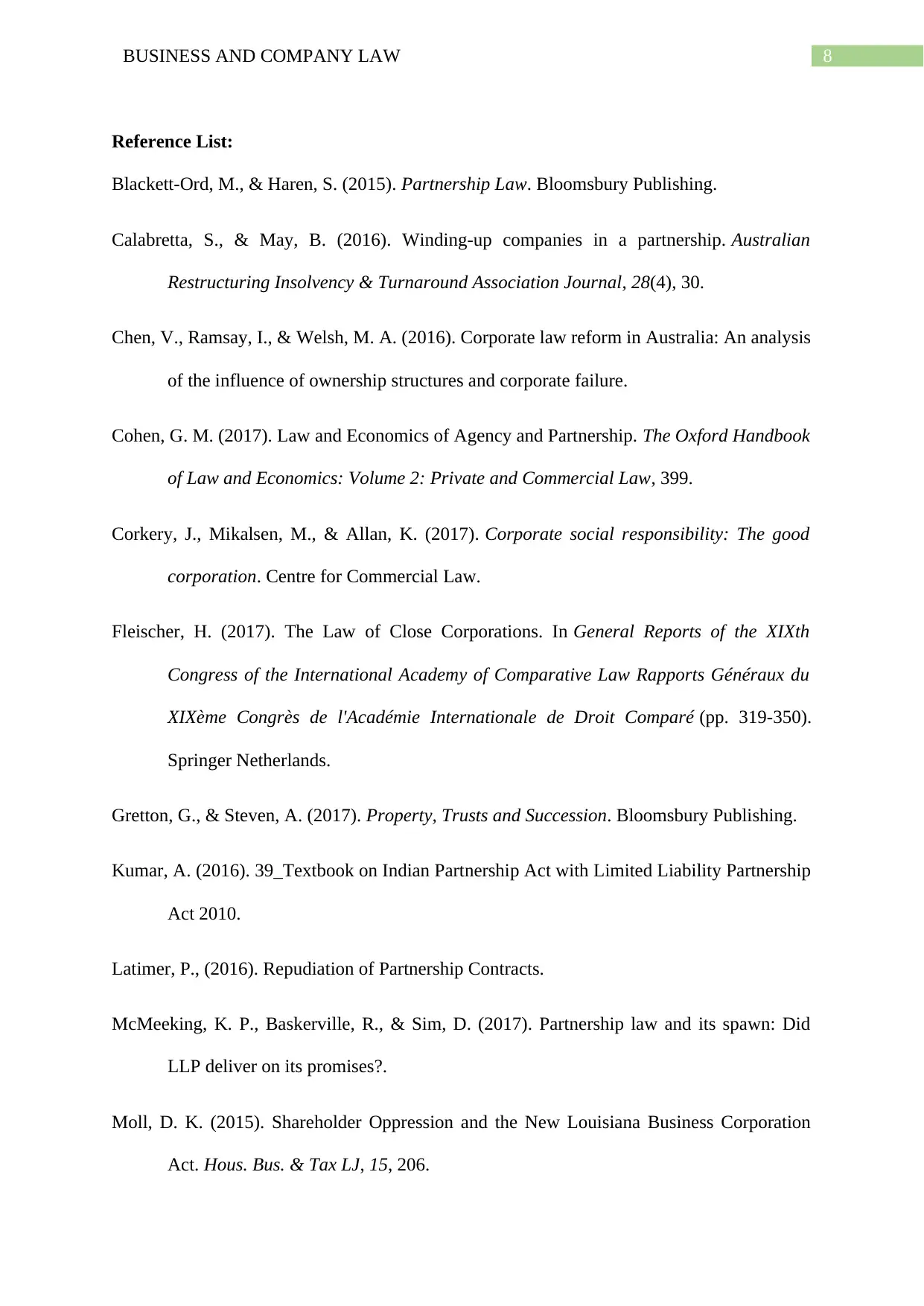
8BUSINESS AND COMPANY LAW
Reference List:
Blackett-Ord, M., & Haren, S. (2015). Partnership Law. Bloomsbury Publishing.
Calabretta, S., & May, B. (2016). Winding-up companies in a partnership. Australian
Restructuring Insolvency & Turnaround Association Journal, 28(4), 30.
Chen, V., Ramsay, I., & Welsh, M. A. (2016). Corporate law reform in Australia: An analysis
of the influence of ownership structures and corporate failure.
Cohen, G. M. (2017). Law and Economics of Agency and Partnership. The Oxford Handbook
of Law and Economics: Volume 2: Private and Commercial Law, 399.
Corkery, J., Mikalsen, M., & Allan, K. (2017). Corporate social responsibility: The good
corporation. Centre for Commercial Law.
Fleischer, H. (2017). The Law of Close Corporations. In General Reports of the XIXth
Congress of the International Academy of Comparative Law Rapports Généraux du
XIXème Congrès de l'Académie Internationale de Droit Comparé (pp. 319-350).
Springer Netherlands.
Gretton, G., & Steven, A. (2017). Property, Trusts and Succession. Bloomsbury Publishing.
Kumar, A. (2016). 39_Textbook on Indian Partnership Act with Limited Liability Partnership
Act 2010.
Latimer, P., (2016). Repudiation of Partnership Contracts.
McMeeking, K. P., Baskerville, R., & Sim, D. (2017). Partnership law and its spawn: Did
LLP deliver on its promises?.
Moll, D. K. (2015). Shareholder Oppression and the New Louisiana Business Corporation
Act. Hous. Bus. & Tax LJ, 15, 206.
Reference List:
Blackett-Ord, M., & Haren, S. (2015). Partnership Law. Bloomsbury Publishing.
Calabretta, S., & May, B. (2016). Winding-up companies in a partnership. Australian
Restructuring Insolvency & Turnaround Association Journal, 28(4), 30.
Chen, V., Ramsay, I., & Welsh, M. A. (2016). Corporate law reform in Australia: An analysis
of the influence of ownership structures and corporate failure.
Cohen, G. M. (2017). Law and Economics of Agency and Partnership. The Oxford Handbook
of Law and Economics: Volume 2: Private and Commercial Law, 399.
Corkery, J., Mikalsen, M., & Allan, K. (2017). Corporate social responsibility: The good
corporation. Centre for Commercial Law.
Fleischer, H. (2017). The Law of Close Corporations. In General Reports of the XIXth
Congress of the International Academy of Comparative Law Rapports Généraux du
XIXème Congrès de l'Académie Internationale de Droit Comparé (pp. 319-350).
Springer Netherlands.
Gretton, G., & Steven, A. (2017). Property, Trusts and Succession. Bloomsbury Publishing.
Kumar, A. (2016). 39_Textbook on Indian Partnership Act with Limited Liability Partnership
Act 2010.
Latimer, P., (2016). Repudiation of Partnership Contracts.
McMeeking, K. P., Baskerville, R., & Sim, D. (2017). Partnership law and its spawn: Did
LLP deliver on its promises?.
Moll, D. K. (2015). Shareholder Oppression and the New Louisiana Business Corporation
Act. Hous. Bus. & Tax LJ, 15, 206.
⊘ This is a preview!⊘
Do you want full access?
Subscribe today to unlock all pages.

Trusted by 1+ million students worldwide
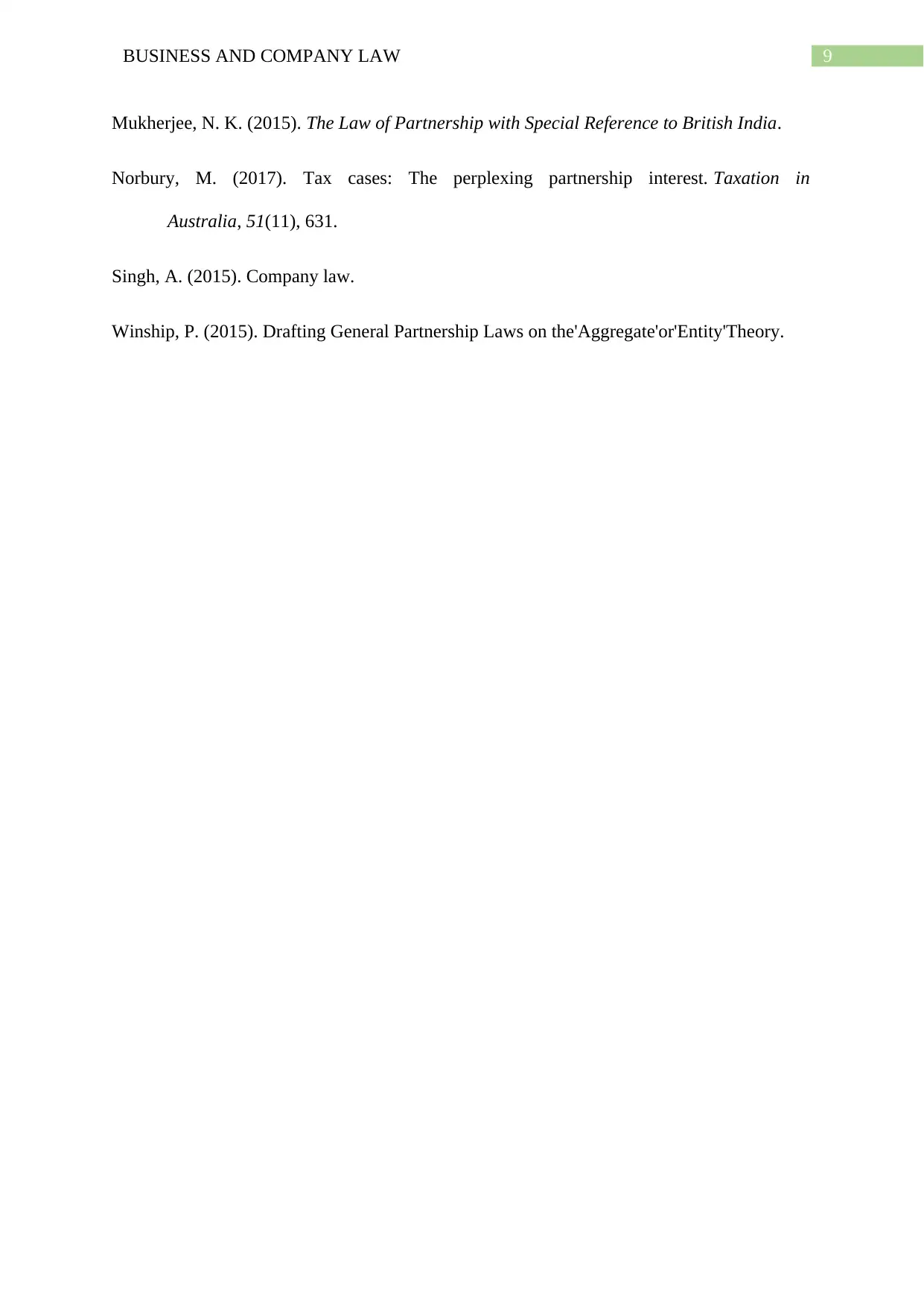
9BUSINESS AND COMPANY LAW
Mukherjee, N. K. (2015). The Law of Partnership with Special Reference to British India.
Norbury, M. (2017). Tax cases: The perplexing partnership interest. Taxation in
Australia, 51(11), 631.
Singh, A. (2015). Company law.
Winship, P. (2015). Drafting General Partnership Laws on the'Aggregate'or'Entity'Theory.
Mukherjee, N. K. (2015). The Law of Partnership with Special Reference to British India.
Norbury, M. (2017). Tax cases: The perplexing partnership interest. Taxation in
Australia, 51(11), 631.
Singh, A. (2015). Company law.
Winship, P. (2015). Drafting General Partnership Laws on the'Aggregate'or'Entity'Theory.
1 out of 10
Related Documents
Your All-in-One AI-Powered Toolkit for Academic Success.
+13062052269
info@desklib.com
Available 24*7 on WhatsApp / Email
![[object Object]](/_next/static/media/star-bottom.7253800d.svg)
Unlock your academic potential
Copyright © 2020–2025 A2Z Services. All Rights Reserved. Developed and managed by ZUCOL.





